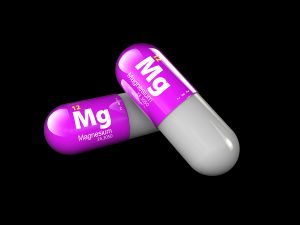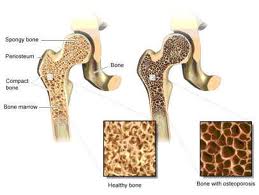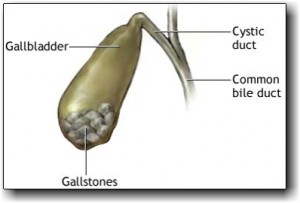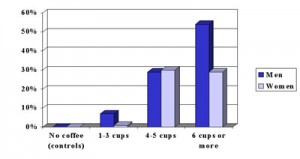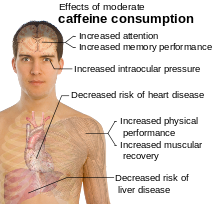Magnesium is an important co-factor in many biochemical reactions, so magnesium is essential to life.
Many diverse diseases and cancers can develop from magnesium deficiency. The key is to supplement with magnesium regularly to get more than the government recommended daily allowance (RDA). The RDA for magnesium is 420 mg a day for males and 320 mg a day for females.
In the following I will review the diseases that occur without enough magnesium on board.
A lack of magnesium can cause heart disease
In this 2014 study 7216 men and women aged 55-80 with at high risk for heart attacks were followed for 4.8 years. The risk of death from a heart attack was found to be 34% lower in the high tertile magnesium group when compared to the lower magnesium tertile group.
The protective mechanism of magnesium was found to be as follows. Magnesium counteracts calcium and stabilizes heart rhythms. Magnesium helps to maintain regular heart beats and prevents irregular heart beats (arrhythmias). It also prevents the accumulation of calcium in the coronary artery walls. This in turn is known to lower the risk of heart attacks and strokes.
Another study, which was part of the Framingham Heart Study, examined calcification of the heart vessels and the aorta as a function of magnesium intake.
There were 2,695 participants in this study. For each increase of 50 mg of magnesium per day there was a 22% decrease in calcification of the coronary arteries. For the same increase of magnesium the calcification of the body’s main artery, the aorta, fell by 12%. Those with the highest magnesium intake were 58% less likely to have calcifications in their coronary arteries. At the same time they were 34% less likely to have calcifications of the aorta.
In a Korean study a group with low magnesium levels was at a 2.1-fold higher risk of developing coronary artery calcifications compared to a group with normal magnesium levels.
Low magnesium increases your stroke risk
In a 2015 study 4443 subjects, men and women aged 40-75 were followed along.
928 stroke cases developed. The researchers compared the group with the highest 30% of magnesium intake with the lowest 10% of magnesium intake. They had significantly lower blood pressure (7 mm mercury) and lower total cholesterol levels. They also had 41% less strokes than those with low magnesium intake.
In a 2015 study that lasted 24 years the authors investigated 43,000 men.
Those with the highest magnesium supplement had a 26% lower stroke risk. Those with the lowest magnesium intake served as a control.
Among women low magnesium levels were shown to cause 34% more ischemic strokes than in controls.
This study included 32,826 participants in the Nurses’ Health Study. Examiners followed them for 11 years.
It is clear from all these studies that supplementation with magnesium can prevent strokes.
Magnesium protects kidney function
This study examined 13,000 adults for 20 years to see how kidney function was dependent on magnesium levels. Those with the lowest magnesium levels had a 58% higher risk of developing chronic kidney disease. It makes sense when you consider that magnesium is necessary to keep arteries healthy, blood pressure low, and blood sugars stable. When diabetics do not control their blood sugars optimally their kidneys develop kidney disease. The term for this is diabetic nephropathy. In the presence of magnesium supplementation and a low sugar diet people are less likely to develop diabetes or kidney disease.
Magnesium helps blood sugar control
A metaanalysis showed that magnesium supplementation was able to improve blood sugar control. This occurred in both diabetics and borderline non-diabetics within 4 months of supplementing with magnesium.
An important factor in helping control blood sugar is magnesium. Here is an article as an example.
Magnesium good for bones and teeth
Magnesium is important for calcium metabolism and this is helping your bones and teeth to stay strong. The bones store half of the body’s magnesium. Another location for magnesium are in our teeth.
Low levels of magnesium lead to osteoporosis, because one of the two structural components of bone (calcium and magnesium) is missing. In addition low magnesium causes inflammatory cytokines to increase. These break down bones. The Women’s Health Initiative showed that when daily magnesium intake exceeded 422.5 mg their hip and whole-body bone mineral density was significantly greater than in those who consumed less than 206.6 mg daily.
With regard to healthy teeth magnesium is important as it prevents periodontal disease.
This study found that there was less tooth loss and there were healthier periodontal tissues in 4290 subjects between 20 and 80.
Those who took magnesium supplements had healthier teeth.
Migraine sufferers improve with magnesium
A double blind randomized study showed that magnesium supplementation can reduce migraines. The researchers in this trial used 600 mg of magnesium supplementation for 4 weeks.
This reduced migraines by 41.6% in the magnesium group compared to the non-supplemented control group.
Another study showed that both intravenous and oral magnesium are effective in reducing migraine headaches.
Intravenous magnesium showed effects on improving migraines within 15 – 45 minutes. The authors concluded that one could supplement other migraine treatments with both oral and intravenous magnesium.
Too little magnesium can cause cancer
It may surprise you to hear that magnesium can even prevent some cancers. Two cancers have been studied in detail. I will limit my discussion to these two.
Pancreatic cancer
One study found that pancreatic cancer was reduced. Researchers recruited 142,203 men and 334,999 women between 1992 and 2000 and included them in the study. After 11.3 years on average 396 men and 469 women came down with pancreatic cancer. On the male side they found that when the body mass index (BMI) was greater than 25.0 there was a 21% reduction of pancreatic cancer for every 100 mg of added magnesium per day. There were a lot of smokers on the female side, which interfered with the study as confounding factors undermined statistical validity.
In another study, the US male Health Professionals Follow-up Study was examined after 20 years of follow-up. Those with a BMI of above 25.0 on magnesium supplementation had a reduced risk of pancreatic cancer. The pancreatic cancer rate in the higher magnesium group was 33% lower than in the lower magnesium group. The higher group consumed 423 mg of magnesium daily, the lower group 281 mg per day. It is significant that in both studies it was the heavier patients who came down with pancreatic cancer. It is common knowledge that obesity is a pancreatic risk factor.
Colorectal cancer
A study done on Japanese men showed that magnesium could protect them significantly from colon cancer.
Men who consumed the highest amount of magnesium developed 52% less colon cancer over 7.9 years. Researchers compared them to the group with the lowest 20% intake of magnesium. The women in this study did not reach statistical significance.
A study from the Netherlands examined colon cancer in patients. They found that only in patients with a BMI of greater than 25.0 magnesium did have protective effects. For every 100 mg of magnesium per day increase there was a 19% reduction of colon polyps. And there was also a 12% reduction of colorectal cancer for every 100 mg increase of magnesium per day.
Magnesium plays an important role in genome stability, DNA maintenance and repair. It also prevents chronic inflammation and reduces insulin resistance, all factors contributing to cancer reduction.
Live longer with magnesium
Consider that magnesium is the fourth most common mineral in the body. Add to this that magnesium is a co-factor of more than 300 enzymes in the body. Magnesium is an important co-factor in the conversion of chemical energy from food that we ingest. Magnesium is regulating blood sugar, blood vessel health and our brain electrical activity. 50% of our stored magnesium is located in our bones, which helps the strength and integrity of them.
Because of the distribution of the enzymes to which magnesium is a co-factor, virtually every cell in the body depends on our regular intake of magnesium.
Magnesium deficiency develops in older age
Since the 1950’s soils have lost magnesium where farmers grow vegetables and raise fruit trees. We simply do not get enough magnesium from food.
But chelated magnesium is freely available in health food stores. Take 250 mg twice per day, and you will have enough.
Because our metabolism slows down, there is a critical age where magnesium deficiency becomes more obvious than when we are younger. By the age of 70 there are 80% of men and 70% of women who do not get the minimum of magnesium-required amount they should get (350 mg for men and 265 mg for women).
Proton pump inhibitors lowering magnesium levels
At this age many people are on multiple drugs. For many proton pump inhibitors (PPI) are used to suppress acid production in the stomach. PPI’s have been associated with low magnesium blood levels. This link explains that when a patient takes PPI’s the total time of taking the medication should not exceed 1 year.
Low magnesium levels accelerate the aging process on a cellular level. Low magnesium levels increase senescent cells that can no longer multiply. Some of them could cause the development of cancer. These senescent cells also can no longer contribute to the immune system. This causes more infections with an adverse outcome.
Remember to take chelated magnesium capsules or tablets 250 mg twice per day and you will be protected from low magnesium levels in your body.
Here is why we live longer with magnesium supplementation
Our blood vessels will not calcify as early; they keep elastic for longer, preventing high blood pressure. Our kidneys will function longer with magnesium, preventing end-stage kidney disease. We need our kidneys to detoxify our system! More than 300 enzymatic reactions all over our body help that we have more energy and also help to prevent cancer. When there are fewer strokes and less heart attacks this helps reduce mortality. Magnesium supplementation helps to lessen the risk for Alzheimer’s disease and also reduces insulin resistance. Researchers have shown that this prevents Alzheimer’s disease.
The bottom line is we live longer and healthier; that is the meaning of longevity.
Conclusion
Magnesium is a key essential mineral. It balances calcium in the body and participates in many enzymatic reactions in the body as a cofactor. As long as we have enough of this mineral we won’t notice anything. It is with magnesium deficiency that things go haywire. Heart disease or a stroke could affect you . You could get kidney disease. And you could even get pancreatic cancer or colorectal cancer. If this is not enough, magnesium deficiency can cause diabetes, osteoporosis and bad teeth. You may suddenly die with no obvious cause. But, if balance your your magnesium blood level by taking regular supplements, you will carry on living and eliminate a lot of health problems.
